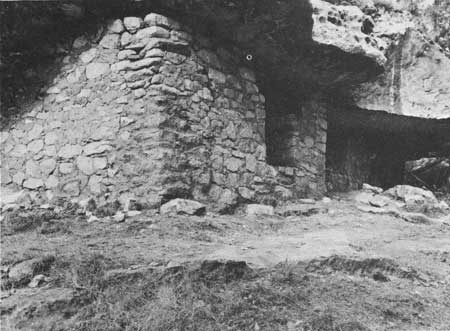|
NATIONAL PARK SERVICE
Ruins Stabilization in the Southwestern United States Publications in Archeology 10 |

|
Appendix 2G
CLIFF DWELLING STABILIZATION
The following are stabilization records for Site NA 333, a four-room cliff dwelling in Walnut Canyon National Monument (figs. 124-126).
RUINS STABILIZATION RECORD
FIRST SHEET
Walnut Canyon National Monument. Date: Oct., 1955; Room: 1; Wall (NESW): NSE. Personnel on job: G. Vivian and R. Richert.
Architecture
Orientation, plan and type (situation, evidence of additional stories, period of construction relative to surrounding rooms, evidence of burning, etc.): This is the southernmost of four contiguous rooms comprising NA 333. Nearly square in plan. Wall junctures indicate that it is at least older than Room 2, but not as old as Rooms 3 and 4. Sequence of construction was probably as follows: Rooms 3 and 4 built as a unit, followed by Room 1 at the south end of the cave, and leaving an open gap as a work area between which was subsequently walled across to form Room 2.
Floor (floor type; additional notes): Unexcavated.
Roof (roof type; additional notes): Cave.
Details (notes on doorways, lintels, etc.): Doorway in center of east wall. Lintels are missing and the area above the door is broken into a V shape. Door is characterized by a high sill.
SECOND SHEET
Room: 1; Date work started: Oct. 12, 1955; Date work finished: Oct. 13, 1955; Work authorized by: G. Vivian, Archeologist.
Condition on date when work started. Ancient masonry: Fair. North Wall: In poorest condition. A large hole beginning at foundation and extending to midsection caused by pot hunters has made this wall extremely weak, and collapsed all of the eastern third except a fragile corner one stone wide. East Wall: Good except for eroded foundation, and the lower third of southeast corner which has collapsed. The V-shaped hole over doorway needs grouting on the north side.
Repair or reconstruction previous to this work: None.
Materials, construction, and technique in making repairs or accomplishing job: North Wall: The large hole measuring 3' x 4' was filled with repair masonry to save the upper section, and the northeast corner was buttressed also to preserve it. Repair work stained with black mortar color to match original.
East Wall: Entire foundation one stone high was grouted and pointed. The south wall also had a few small holes along the foundation row where original soil-mortar had eroded and these were filled. Sill and wall area below door grouted and pointed.

|
| FIGURE 124. Cans of water and large bucket of stabilized mortar suspended from carrier and riding across canyon to the project. (Walnut Canyon National Monument) |

|
| FIGURE 125. Room 1, east exposure, before replacement of fallen corner. (Walnut Canyon National Monument) |

|
| FIGURE 126. Room 1, east exposure, after replacement of fallen corner. The deeply eroded wall base was grouted, and the area above the doorway was partially reset. (Walnut Canyon National Monument) |
| <<< Previous | <<< Contents>>> | Next >>> |
archeology/10/app2g.htm
Last Updated: 16-Apr-2007